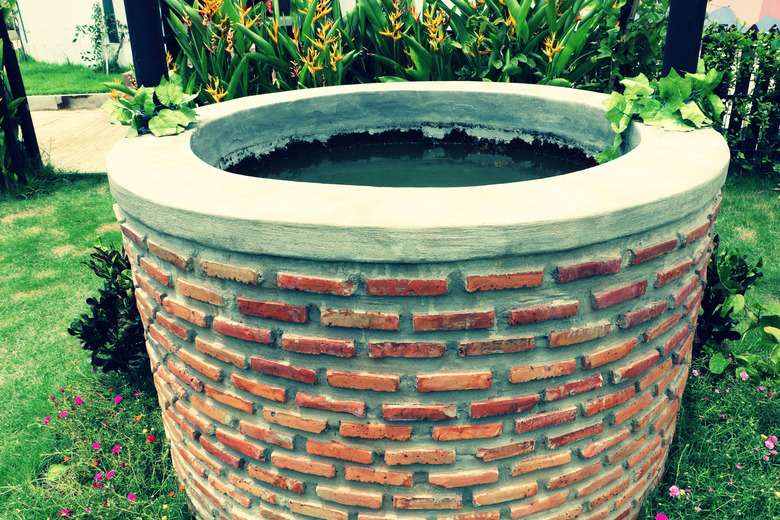Where Does The Water In A Well Come From?
Well water allows many humans to access fresh water in rural regions and areas without easy access to city water. Access to fresh water might not seem like a luxury, but in places with little infrastructure in place, wells provide vital and simple access to water. But exactly what is a well? And where does well water come from?
What Is a Well?
What Is a Well?
You've probably heard the term "well" and "well water" before, but might wonder about the specifics. What is a well? A well is essentially an opening that runs deep into the ground, past the water table, and pulls groundwater back to the surface for use. The well uses a pump to bring water from deep below the ground back to the surface through a pipe.
Three different types of water wells exist – dug wells, driven wells and drilled wells. The first type, dug wells, are likely what you picture when you think of an "old-timey" well, or something you might see in a television show set in ancient times. They have a wide diameter, shallow depth, are typically lined with brick or stone and have some type of receptacle, such as a bucket, attached to a rope or chain to access the water.
People create driven wells by driving a pipe directly into the ground. These wells typically measure up to 50 feet deep. Drilled wells can be constructed much deeper, reaching thousands of feet beneath the ground. They require specific drilling or percussion equipment to bore into the ground.
What Is the Water Table and Groundwater?
What Is the Water Table and Groundwater?
The terms "water table" and "groundwater" might sound a bit confusing, but they're actually surprisingly simple concepts! Many layers of sand, soil, rock and various sediments exist beneath the ground. As you dig deeper, you will reach a layer where you hit water. This point is known as the water table.
Beneath the water table, the ground is saturated with water known as groundwater. The location of the water table changes based on the volume of groundwater. The amount of groundwater varies based on several different elements, including the season, amount of rainfall and more.
Where Does Groundwater Come From?
Where Does Groundwater Come From?
You know wells pull from the groundwater beneath the surface, but where does well water come from originally? Groundwater, and thus well water, comes from rain. Rainfall helps replenish the groundwater beneath your feet and keeps wells working properly. When rain falls onto a permeable surface, such as grass or soil, it seeps into the ground.
The water continues to percolate downward through the spaces in the soil and rock until it reaches the water table. Large amounts of rain will raise the water table, while drought will lower the water table. However, construction and urban sprawl have impacted groundwater levels through the use of impervious, or impermeable, surfaces.
The Trouble With Impermeable Surfaces
The Trouble With Impermeable Surfaces
An impervious surface or impermeable surface is a surface the water cannot pass through to reach the soil and percolate down to the water table. Roads, parking lots and other concrete or asphalt surfaces are perfect examples of this. Instead of soaking through the ground, the water is diverted, often through drains and other systems. Most of these drains go directly to waterways such as rivers or the ocean.
Two huge problems can arise from this process. First, without the rain to "recharge" or refill the groundwater, the water table can fall lower into the ground. This can result in shallower wells drying up and no longer having access to water if their piping doesn't reach below where the water table has fallen to.
Another serious implication of impervious surfaces is pollution. Filtering through layer upon layer of sand, gravel and rock works to remove many pollutants and toxins from the water. However, when the water simply washes into drains and then runs into local waterways, it flushes pollutants into those waterways, resulting in water pollution.
References
- Extension Foundation: How Does a Well Actually Work to Supply Drinking Water?
- National Geographic: Water Table
- Spokane Aquifer Joint Board: What Is Groundwater?
- PennState Extension: Impermeable Surfaces Create a Multitude of Problems for Waterways
- United States Environmental Protection Agency: Learn About Private Water Wells
Cite This Article
MLA
Zinni, Yasmin. "Where Does The Water In A Well Come From?" sciencing.com, https://www.sciencing.com/where-does-the-water-in-a-well-come-from-13404815/. 20 October 2021.
APA
Zinni, Yasmin. (2021, October 20). Where Does The Water In A Well Come From?. sciencing.com. Retrieved from https://www.sciencing.com/where-does-the-water-in-a-well-come-from-13404815/
Chicago
Zinni, Yasmin. Where Does The Water In A Well Come From? last modified March 24, 2022. https://www.sciencing.com/where-does-the-water-in-a-well-come-from-13404815/
